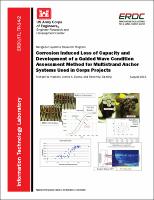Please use this identifier to cite or link to this item:
https://hdl.handle.net/11681/10868| Title: | Corrosion induced loss of capacity and development of a guided wave condition assessment method for multistrand anchor systems used in Corps projects |
| Authors: | Navigation Systems Research Program (U.S.) Haskins, Richard W. Evans, James A. Ebeling, Robert M., 1954- |
| Keywords: | Corrosion Multistrand anchor systems Seven strand wire cables Seven wire strand cables Wire pull tests Digital photography Morphological processing Nondestructive testing NDT Navigation Systems Research Program (U.S.) |
| Publisher: | Information Technology Laboratory (U.S.) Engineer Research and Development Center (U.S.) |
| Series/Report no.: | ERDC/ITL TR ; 14-2. |
| Description: | Technical Report Abstract: Over the past five decades, the US Army Corps of Engineers has worked to upgrade its projects by installing high-capacity, post-tensioned foundation anchors. These stressed steel tendons have been used to strengthen hydraulic structures and to improve their serviceability and stability. The goal has been to achieve structural stability for Corps hydraulic concrete structures and/or to remediate cracked concrete monoliths. Substantial improvements to protect multistrand anchor systems from corrosion have been made since they were first used in Corps projects more than 50 years ago, but the corrosion of older multistrand anchor systems is still a major concern. As a result of needs within the USACE, researchers at the US Army Engineer Research and Development Center (ERDC) are developing engineering procedures to estimate the current state of load-carrying capacity and to estimate the remaining service life of these tendons. These tools also aim to establish the rate of deterioration of anchorage capacity (with time), so costly replacement of ground anchorage can be delayed until absolutely needed. Analytical, laboratory, and field-testing efforts will be used to develop a methodology and analytical models to predict deterioration and loss of strength. Probabilistic procedures will be used to quantify uncertainties for the primary variable resulting in loss of strength of the post tensioned tendon. These uncertainty parameters will be carried into the risk-based analytical model. Procedures to extend the life of deteriorating multistrand tendons will be investigated. This report discusses the progress made since publication of the authors’ first research report, ERDC TR-13-3. This report discusses ERDC’s recent advances in the initial phase of a laboratory testing program to estimate seven strand wire cable strength as a function of cross sectional material loss. Cable strength is measured by performing a pull test to failure on corroded specimens, as well as specimens with manufactured defects. An innovative morphological procedure using digital photography was developed for quantifying the geometrical properties of cable near their failure locations. Fundamental research into Nondestructive testing (NDT) methods to assess the condition of post-tensioning seven strand wire cables is also discussed, with a focus on the guided wave approach. |
| Rights: | Approved for public release; distribution is unlimited. |
| URI: | http://hdl.handle.net/11681/10868 |
| Appears in Collections: | Technical Report |
Files in This Item:
| File | Description | Size | Format | |
|---|---|---|---|---|
| ERDC-ITL-TR-14-2.pdf | 9.36 MB | Adobe PDF |  View/Open |